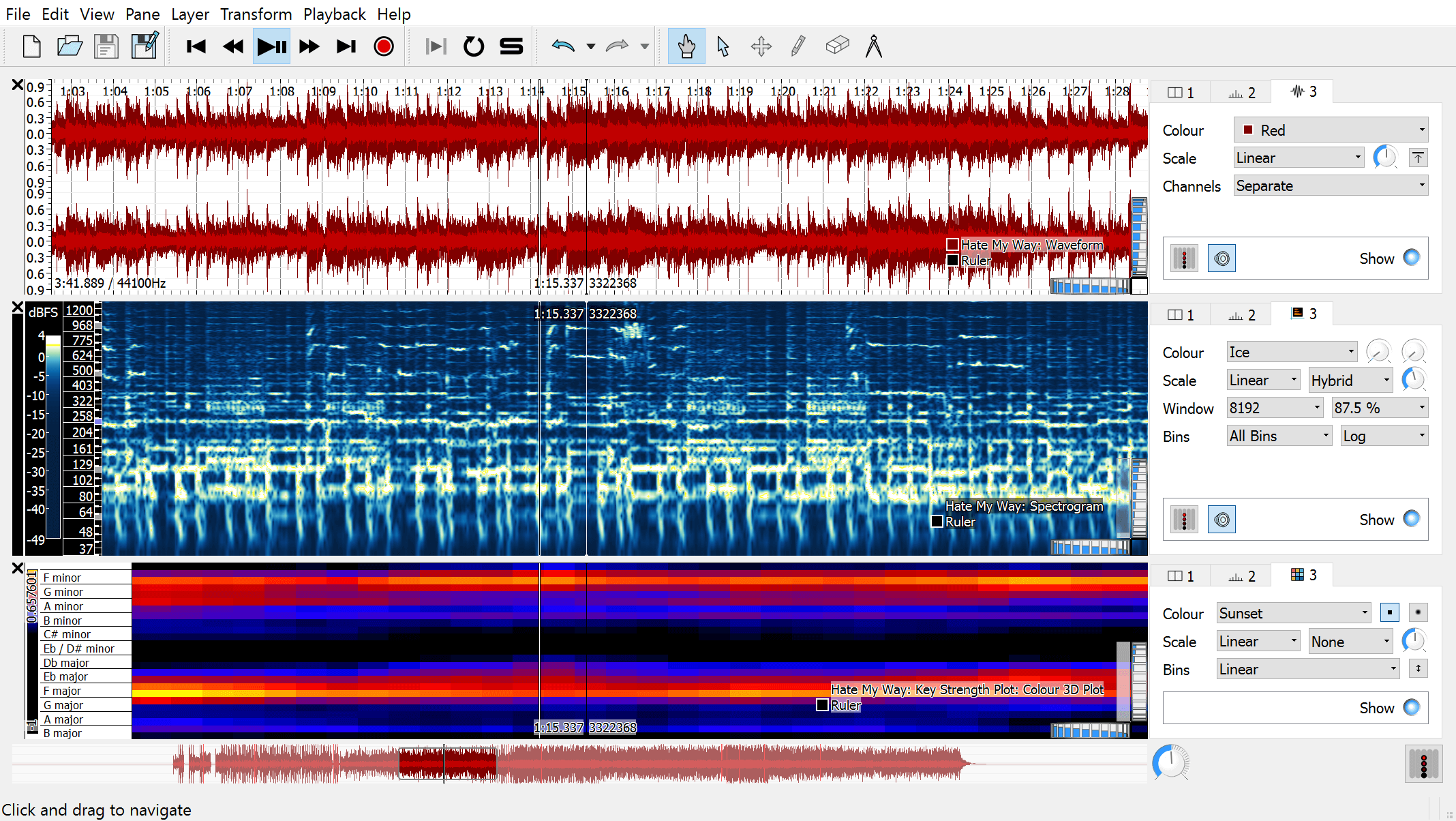Sonic Visualiser Download For Windows
Sonic Visualiser is a free, open-source application for Windows, Linux, and Mac, designed to be the first program you reach for when want to study a music recording closely. It’s designed for musicologists, archivists, signal-processing researchers, and anyone else looking for a friendly way to look at what lies inside the audio file. It mainly uses for viewing and analyzing music files.
 It aims to provide a user-friendly tool for displaying spectrograms and audio waveforms, ensuring compatibility with some of the most common audio formats (such as WAV, MP3, AIFF, AVR, FLAC, OGG, RAW), as well as less popular file types (AU, CAF, HTK, IFF, MAR, MPC, PVR, RF64, SDS, W64, WVE, XI). Moreover, it enables you to import from music note data from locally stored MIDI files and display it alongside the waveform.
It aims to provide a user-friendly tool for displaying spectrograms and audio waveforms, ensuring compatibility with some of the most common audio formats (such as WAV, MP3, AIFF, AVR, FLAC, OGG, RAW), as well as less popular file types (AU, CAF, HTK, IFF, MAR, MPC, PVR, RF64, SDS, W64, WVE, XI). Moreover, it enables you to import from music note data from locally stored MIDI files and display it alongside the waveform.

Sonic Visualiser For Analyzing Music Features
- Load audio files in WAV, Ogg and MP3 formats, and view their waveforms.
- Look at audio visualizations such as spectrogram views, with interactive adjustment of display parameters.
- Annotate audio data by adding labeled time points and defining segments, point values, and curves.
- Overlay annotations on top of one another with aligned scales, and overlay annotations on top of waveform or spectrogram views.
- View the same data at multiple time resolutions simultaneously (for close-up and overview).
- Run feature-extraction plugins to calculate annotations automatically, using algorithms such as beat trackers, pitch detectors, and so on.
- Import annotation layers from various text file formats.
- Import note data from MIDI files, view it alongside other frequency scales, and play it with the original audio.
- Playback the audio plus synthesized annotations, taking care to synchronize playback with display.
- Select areas of interest, optionally snapping to nearby feature locations, and audition individual and comparative selections in seamless loops.
- Time-stretch playback, slowing right down or speeding up to a tiny fraction or huge multiple of the original speed while retaining a synchronized display.
- Export audio regions and annotation layers to external files.
The design goals for Sonic Visualiser For Music Analyzing
- To provide the best available core waveform and spectrogram audio visualizations for use with substantial files of music audio data.
- To facilitate ready comparisons between different kinds of data, for example by making it easy to overlay one set of data on another, or display the same data in more than one way at the same time.
- To be straightforward. The user interface should be simpler to learn and to explain than the internal data structures. In this respect, The app aims to resemble a consumer audio application.
- To be responsive, slick, and enjoyable. Even if you have to wait for your results to be calculated, you should be able to do something else with the audio data while you wait. It is pervasively multithreaded, loves multiprocessor and multicore systems, and can make good use of fast processors with plenty of memory.
- To handle large data sets. The work the program does is intrinsically processor-hungry and (often) memory-hungry, but the aim is to allow you to work with long audio files on machines with modest CPU and memory where reasonable. (Disk space is another matter.)
The application features options for modifying the way data is displayed. As such, you can freely adjust the zoom level both horizontally and vertically, so as to focus on any area of the waveform and analyze it in detail.
The selection tools enable you to define waveform sections and compare them much easier. For your convenience, This software can also slow down the playback to such an extent that it reaches 10% of the initial speed.
One of the worth-mentioning features is the possibility to import and overlay annotation layers (CSV, LAB, MID, TXT) on top of waveform representations. Furthermore, it comes with a set of integrated plugins that allow automatic calculations of annotations, taking into account tuning and sound pitch.
Pros And Cons of Sonic Visualiser For Music Analyzing
| Pros | Cons |
| Many visualization options | No direct support for VST plugins |
| Annotation tools | |
| Audio player integrated | |
| Gives detailed info on audio files |
System Requirements
| Processor | Pentium 4 or AMD 64 processors |
Technical Specification
| Software Name | Sonic Visualizer Software For Windows V 4.2 |
| File Size | 20.2 MB |
| Languages | English, Italian, French, Spanish, Polish, Chinese, German, Japanese |
| License | Opensource |
| Developer | Chris Cannam |
Official Video Intro Sonic Visualiser Software
Sonic Visualiser Software Older Versions
| Version Name | Size | Download |
| sonic-visualiser-4.2-win64 | 20.2 MB | Download |
- Transcribe!
- Amazing Slow Downer
- Capo
- AudioRetoucher
- Sonic Atom
- MusicTrans
Sonic Visualiser Software Overview

Technical Specification
| Version | 4.4 |
| File Size | 19.6 MB |
| Languages | English, Italian, French, Spanish, Polish, Chinese, German, Japanese |
| License | Opensource |
| Developer | Chris Cannam |
Conclusion
Sonic Visualiser enables you to explore and get close-ups on the structure of an audio file, providing advanced annotation options to help you write down your findings. It comes with a broad toolset and options for managing spectrum data and layers, allowing audio playback and signal comparison.
ad



Comments are closed.